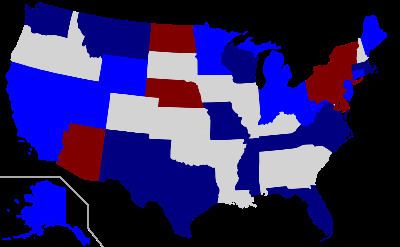49 47 64 34 20,620,465 16,180,851 Start date November 4, 1958 | 24 8 15 13 55.0% 43.1% | |
 | ||
The United States Senate elections of 1958 (and subsequent special elections in 1959) were elections for the United States Senate which occurred in the middle of President Dwight D. Eisenhower's second term. As is common in midterm elections, the party in the White House lost seats, but losses this year were on a huge scale, perhaps due to the high unemployment of the Recession of 1958. The Eisenhower Administration's position on right-to-work issues galvanized labor unions which supported Democrats. The launch of Sputnik may also have been a factor. The Democratic Party took thirteen Republican seats (10 of them by defeating incumbents), and also won both Senate seats in the new state of Alaska. Senate elections in 1959 in the new state of Hawaii were split between the two parties; combined with the 1958 results, this yielded an aggregate gain of 16 seats for the Democrats for a party balance of 65-35. This is the largest swing in the history of the Senate, and is only the second time in U.S. history that 10 or more Senate seats changed hands in a midterm election (after 1946).
Contents
- New Democratic seats
- Democrats
- Republican seats held by Republicans
- Republicans replaced by Democrats
- Democrats replaced by Republicans
- Results summary
- Special elections during the 85th Congress
- Elections leading to the next Congress
- Elections during the 86th Congress
- Connecticut
- Montana
- Nevada
- North Dakota
- Pennsylvania
- Vermont
- Virginia
- References
New Democratic seats
- Alaska (class 2): won by Bob Bartlett
- Alaska (class 3): won by Ernest Gruening
Democrats
No Democrats retired.
Republican seats held by Republicans
- New York: Irving M. Ives, replaced by Kenneth B. Keating
- Pennsylvania: Edward Martin, replaced by Hugh Scott
- Vermont: Ralph E. Flanders, replaced by Winston L. Prouty
Republicans replaced by Democrats
- California: William F. Knowland, replaced by Clair Engle
- Indiana: William E. Jenner, replaced by Vance Hartke
- New Jersey: H. Alexander Smith, replaced by Harrison A. Williams, Jr.
Democrats replaced by Republicans
No Democrats lost re-election.
Republicans replaced by Democrats
West Virginia's delegation changed from two Republicans to two Democrats.
- Connecticut: William A. Purtell, lost to Thomas J. Dodd
- Maine: Frederick G. Payne, lost to Edmund S. Muskie
- Michigan: Charles E. Potter, lost to Philip A. Hart
- Minnesota: Edward John Thye, lost to Eugene McCarthy
- Nevada: George W. Malone, lost to Howard W. Cannon
- Ohio: John W. Bricker, lost to Stephen M. Young
- Utah: Arthur V. Watkins, lost to Frank E. Moss
- West Virginia: William C. Revercomb, lost to Robert C. Byrd
- West Virginia (Class 2): John D. Hoblitzell, Jr., lost to Jennings Randolph
- Wyoming: Frank A. Barrett, lost to Gale McGee
Results summary
For the November 5 and November 25, 1958 general and special elections.
Colored shading indicates party with largest share of that row.
Special elections during the 85th Congress
In these special elections, the winner was seated during 1958 or before January 3, 1959; ordered by election date.
Elections leading to the next Congress
In these general elections, the winners were elected for the term beginning January 3, 1959; ordered by state.
All of the elections involved the Class 1 seats.
Elections during the 86th Congress
In these special elections, the winners were seated after January 3, 1959.
Connecticut
In Connecticut, Democratic Thomas J. Dodd defeated incumbent senator William A. Purtell who ran for a second term.
Montana
In Montana, incumbent United States Senator Mike Mansfield, who was first elected to the Senate in 1952, ran for re-election. Mansfield won the Democratic primary comfortably, and moved on to the general election, where he was opposed by Lou W. Welch, a millworker and the Republican nominee. In contrast to the close campaign in 1952, Mansfield defeated Welch in a landslide and won his second term in the Senate easily.
Nevada
In Nevada, incumbent Republican U.S. Senator George W. Malone ran for re-election to a third term, but was defeated by Democrat Howard Cannon.
North Dakota
In North Dakota, the incumbent, Republican and former Non-Partisan League (NPL) Senator William Langer, was re-elected to a fourth term, defeating North Dakota Democratic NPL Party (Dem-NPL) candidate Raymond G. Vendsel.
Only Langer filed as a Republican, and the endorsed Democratic-NPL candidate was Raymond G. Vendsel. Langer and Vendsel won the primary elections for their respective parties.
Two independent candidates, Arthur C. Townley and Custer Solem, also filed before the deadline but had minimal impact on the outcome of the election, totaling less than 3,000 votes combined. Townley was known as the creator of the National Non-Partisan League, and had previously sought North Dakota's other senate seat in 1956.
Pennsylvania
In Pennsylvania, incumbent Republican U.S. Senator Edward Martin did not seek re-election. The Republican nominee, Hugh Scott, defeated Democratic nominee George M. Leader for the vacant seat.
Vermont
In Vermont, incumbent Republican Ralph Flanders did not run for re-election to another term in the United States Senate. Republican candidate Winston L. Prouty defeated Democratic candidate Frederick J. Fayette to succeed him.
Virginia
In Virginia, incumbent Senator Harry F. Byrd, Sr. was re-elected after defeating Independent Louise Wensel and Social Democrat Clarke Robb.
